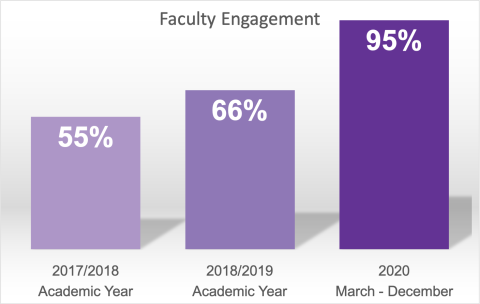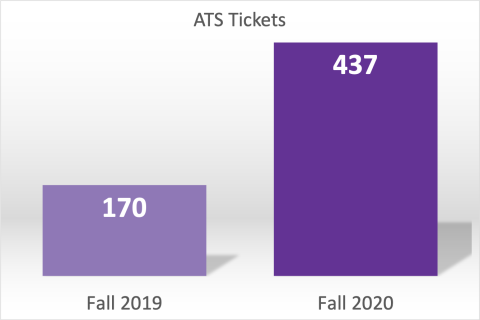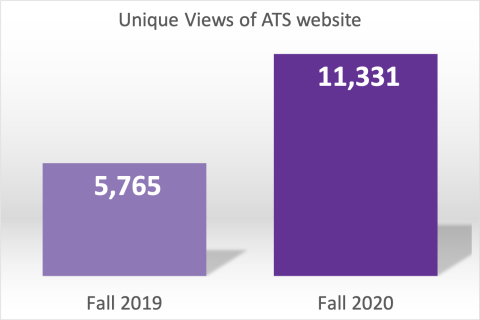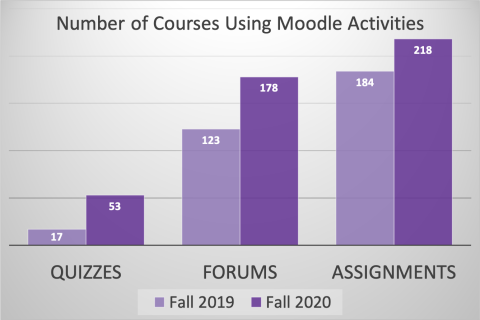March - December 2020 - ATS’ COVID Response
Increased Faculty Engagement

ATS met this growing need for faculty support in a number of ways, which are detailed here.
Jump to: Summer 2020 Faculty Programs ♦ ATS Work Portfolio Expands in Breadth and Depth ♦ Faculty Access of ATS Resources ♦ Increased Use of Moodle Activities
Summer 2020 Faculty Programs

- 80% of faculty (155 unique) scheduled to teach in fall 2020 attended the 6-week summer ACUE Flexible Course Design Seminar program. ATS co-ran the program with the Center for Community Engagement (CCE) and the Center for Teaching & Learning (CTL).

- 20% of faculty (40 unique) teaching in fall 2020 participated in the fall 2U program.
- ATS served as project manager for this partnership and partnered with CTL.
- Although only 10% of the fall 2020 courses ran on the 2U platform, 50% of the students participated in these courses because these classes were all large classes (from 35 students to 100+ students in a class)
- ATS continues to be the project manager in spring 2021.
ATS Work Portfolio Expands in Breadth and Depth

ATS works with faculty in many ways, assisting with a wide range of requests and queries. About 40% to 50% of the ATS work portfolio is covered through AskIT tickets from faculty.
During the pivot to remote education, ATS handled a high volume of tickets and effectively problem-solved a wide range of digital pedagogy issues for remote teaching, including complex HyFlex scenarios.
Breadth:
- During the initial COVID-19 transition period (March-May 2020), ATS received triple the number of tickets received during the same time period the previous year (248 in 2019 vs. 754 in 2020).
- In Fall 2020, ATS continued to provide an elevated level of support to faculty, receiving more than double the number of tickets received in Fall 2019 (170 in 2019 vs. 437 in 2020).
Depth:
- As the number of submitted tickets grew, so did the complexity of the requests, as faculty began to use new tools and pedagogical approaches (or expand usage of existing ones).
- The overall number of steps per ticket increased. For example, working with faculty for student engagement activities on Zoom involved more steps as additional features and privacy protections were added to the Zoom program.
- In addition to solving faculty queries via tickets, ATS met faculty needs through multiple methods - email, workshops, consultations, and in-class sessions.
- This evidence showed the need to build capacity within the ATS team and directly led to ATS hiring a new team member to help manage the increased support needs. Check out Kara McGillicuddy’s profile here.
Faculty Access of ATS Resources

Many of these pages were already created by ATS prior to the COVID-19 transition period. However, these resources were quickly supplemented with new information about the tools that faculty were starting to use.
A few of the new pages that were created during this time include:
- Zoom for Teaching & Learning: FAQ
- Top 10 Things to Know About Moodle
- Creating Video-Based Lecture: Examples from Amherst Faculty
Increased Use of Moodle Activities

The total amount of combined faculty and student access of Moodle course sites rose from 429,653 in Fall 2019 to 669,435 in Fall 2020. This has meant higher support needed from ATS for digital integration and interactivity, as Moodle has become a lifeline for the management of online teaching and learning.
In particular, three Moodle activities showed the most significant increase in usage between Fall 2019 and Fall 2020 - quizzes, forums, and assignments. The number of courses using quizzes grew from 17 to 53, the number using forums increased from 123 to 178, and the number of courses using assignments went from 184 to 218.
ATS Supports the Pivot to Remote Education
- Carrying the Pedagogical Vision to Fruition
- Rapid Research & Implementation of Academic Technology Tools
- Universal Design for Learning with Technology
Published Spring 2021 by Academic Technology Services